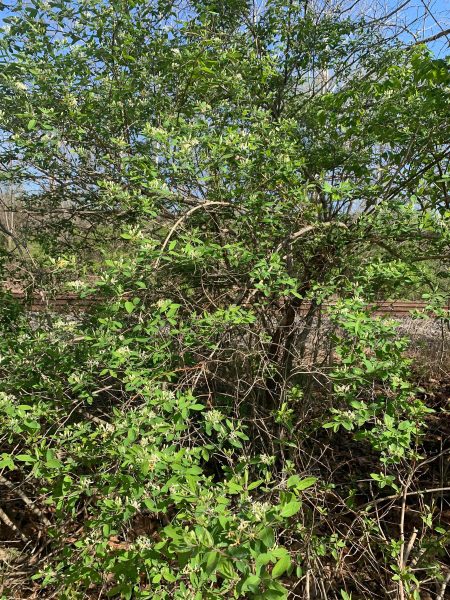Morrow's Honeysuckle
Lonicera morrowii
Morrow’s honeysuckle is an invasive deciduous shrub with white, tube-shaped flowers. It can be found throughout the Chesapeake Bay watershed.
This section shows one large critter image at a time. Use the thumbnails that follow to select a specific image to display here.

This gallery contains a grid of small thumbnails. Selecting a thumbnail will change the main image in the preceding section.
Appearance
Morrow’s honeysuckle is a deciduous shrub that sits upright. On average it will grow seven feet tall. It has oblong, opposite leaves that grow on short stalks. Leaves are 1-2 inches in length. The plant has white, tubular, 5-petaled flowers and red- or orange-colored berries.
Predators
Birds and small mammals feed on the fruit of Morrow’s honeysuckle, which is poisonous to humans. The fruit, though abundant and carbohydrate-rich, do not offer the same source of high-fat, nutrient-rich food to migrating birds that native plant species do.
Reproduction and life cycle
Morrow’s honeysuckle leafs comparatively early in the spring, and is often one of the first shrubs with foliage. Flowers bloom from late April through early May, and berries mature in July and last through the winter. Seeds are spread by birds that eat the fruit.
Did you know?
- Morrow’s honeysuckle is an invasive plant that was originally imported to the United States in the 1800s. It was used as an ornamental, as food for wildlife and for soil erosion control. The shrub forms dense thickets which outcompetes native plants for space and sunlight.
- Invasive honeysuckles like Morrow’s can be easily confused with native honeysuckle bushes, so proper identification is necessary. In native honeysuckle plants, the inside of the stem is solid and white-colored; Morrow’s honeysuckle has stems that are hollow and tan-colored on the inside.
- Birds and small mammals feed on the fruit of Morrow’s honeysuckle, which is poisonous to humans. The fruit, though abundant and carbohydrate-rich, do not offer the same source of high-fat, nutrient-rich food to migrating birds that native plant species do.
- Over the last few decades, cedar waxwings with orange-tipped tails have been recorded. This color variation is thought to be a result of the birds eating Morrow’s honeysuckle, which contains a red pigment known as rhodoxanthin. The red combines with the bird’s natural yellow tail pigmentation to produce an orange color.
Sources and additional information
- Plant Invaders of Mid-Atlantic Natural Areas – National Park Service and U.S. Fish and Wildlife Service
- Morrow’s honeysuckle – USDA Natural Resources Conservation Service Plants Database
- Lonicera morrowii – Invasive Plant Atlas of the United States
- Exotic Bush Honeysuckles – Cornell Cooperative Extension
